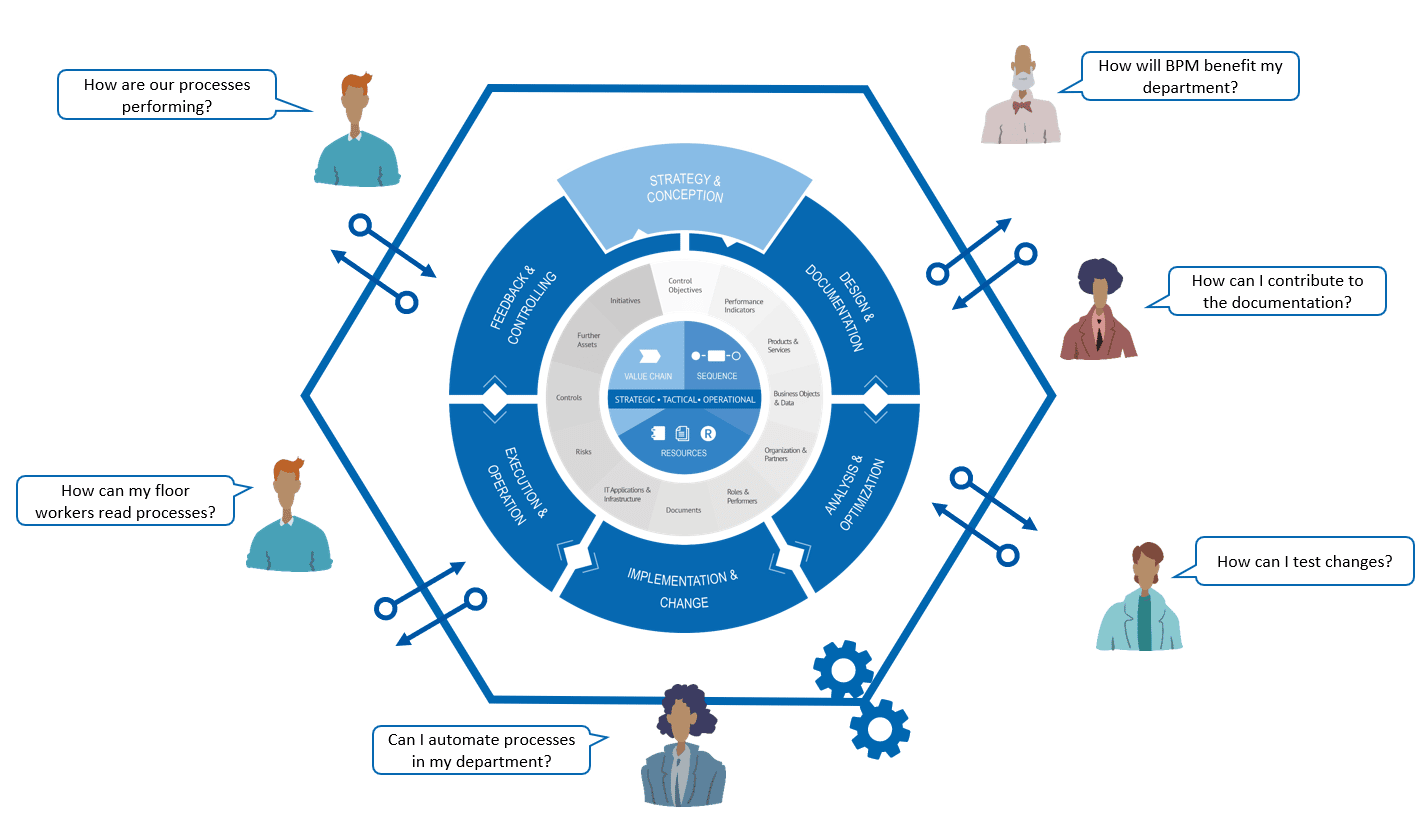Introduction
Picture the following scenario: You’ve introduced Business Process Management with an aim to transform the way your organization thinks and works around processes. Following your thorough research, the road ahead seems rather straightforward – identify, analyse and improve your business processes to satisfy the evolving customer needs, boost efficiencies, cut costs and improve business performance overall.
However, to turn this well-planned-out vision into reality and unlock BPM’s true potential with BPM free e-learning, everyone needs to get on board and integrate the practice of process management into their daily activities. And this is usually where many companies start facing challenges.
After making a case to your executives and involving process owners to contribute to your first process landscape, process management starts slowly becoming part of your organization. Nevertheless, after a while it appears that the department heads are reluctant to allocate resources and adapt their workflows. The end-users are struggling with your BPM tool and show resistance to changing their routine. And even the (previously-convinced) executives are starting to express their doubts.
If any of it sounds familiar and applicable to you, then you might have a problem with what we like to call process marketing. And luckily, we have some great tips and best practices to share on the matter. So if you want to learn key tactics on raising process awareness in your organization and setting up a successful internal process marketing strategy – be sure to continue reading this blog post!
Managing expectations
Let’s take a step back and start from the beginning – what is internal marketing actually and why is it a cornerstone for your Business Process Management initiatives? Internal marketing is the process of promoting your organizational goals, mission, short-term and long-term objectives, as well as corporate values to all of your employees. Establishing direct and frequent communication facilitates knowledge-transfer throughout your organization, and ensures that all employees have central access to essential information. However, the ultimate goal of internal communication is: fostering a sense of companionship and trust between employees and management. As a result, this also creates a sense of common purpose and motivates the employees to work cooperatively towards a shared goal.
When establishing internal marketing practices, it is crucial to consider that different stakeholders, especially executives and department heads, may have different information needs and expectations from the other colleagues. For instance, executives might prefer a brief overview of the overall performance, and a summary of positive (but also negative) effects of introducing process management, as opposed to an in-depth review of each process.
The department heads, on the other hand, have more interest in a thorough analysis – in an effort to pinpoint optimization and automation potentials that can increase their processes’ efficiency. Therefore, your internal marketing strategy should be tailored to the needs of different stakeholders. Now, you may think this just adds additional complexity to the situation, but in reality, it is the ultimate opportunity to take your BPM to the next level, and here is how.
Follow our best practices
As mentioned above, internal marketing should be built on the principles of effective and honest communication – engaging your colleagues, and motivating them through setting common goals and various tangible benefits. We have derived our best practices with specific steps you can take to improve your internal communication and engagement with stakeholders:
Communicate process management
Regardless of the hierarchical position of your stakeholders, effective communication is key. Provide transparent and honest information and ensure regular reporting to your executives. Create and share reports directly through your BPM system, provide an interface to their preferred business intelligence software or consider giving them access to the system, so they can generate reports according to their needs and interest.
Make sure that they are familiar with the basic reporting functionalities of your system. On top of that, try to involve the department heads and get them on board with your initiative as soon as possible. Communicate the reasons behind, and the goals of your initiative before embarking on it fully. Once the system is implemented and the process landscape defined, make sure that the end users have been instructed on how to use the tool and how it will benefit their every-day work life.
Engage your target audience
Start with implementing a KPI monitoring system which can be easily accessed by all stakeholders. Educate them on the basic functionalities of your tool and schedule monthly meetings to communicate the progress of your initiative. And remember: it’s a cycle, not a straight line.
So, how can you ensure that your department heads will contribute to the organization’s process knowledge? Distribute clear responsibilities and communicate your expectations on their contribution. Make sure you educate them on using the system as contributors and explain how process management in your organization depends on the quality of their contribution. In general, the more you know about the actual processes that are executed daily in their departments, the more they will benefit from process optimization.

Motivate with benefits
The benefits of standardized, streamlined and monitored processes should be clear to everyone in your organization. Make sure to reiterate these benefits each time you present results or share reports. The middle-management often needs more precise information on tangible benefits, such as cost saving or increased efficiency. This is especially prominent in the departments that deliver supporting processes, such as HR.
So, be sure to explain to them how their processes can be automated with sufficiently accurate knowledge of their daily activities. Talk to the production managers about how they can test potential changes in process simulation engines by collecting appropriate data. Explain how tracking real-life process info can help realize savings to your head of procurement. And repeat these principals in communication with all other departments and their representatives.
Essentially, you need to set up a BPM system that will support all your needs and expectations for process marketing. With the Business Process Management tool ADONIS, you can be sure that all your process modelling, process automation, process documentation and many other initiatives will live up to their fullest potential. With various possibilities from sharing process knowledge through Confluence integration, to connecting with process mining tools to create powerful simulations, ADONIS can support you along the whole path towards achieving your operational excellence.
Summary
Promoting BPM in your organization can be a challenging task, as it requires an adaptable approach to meet the varying needs and expectations of all stakeholders. An important step therefore, is establishing internal process marketing – to build awareness and understanding among the employees about the benefits of a BPM system, and how it can help them efficiently achieve their goals and objectives.
Motivation is another important factor, as the employees are more likely to integrate the practice if they feel motivated and engaged. And last but not least, do not neglect the importance of education and training, because the unknown often seems more scary and risky until it’s properly explored.
If you are struggling to promote BPM in your organization, we are always here to support you. You can reach out to us directly to discuss your process marketing challenges and learn how ADONIS and BOC Group can help you overcome them effectively!







